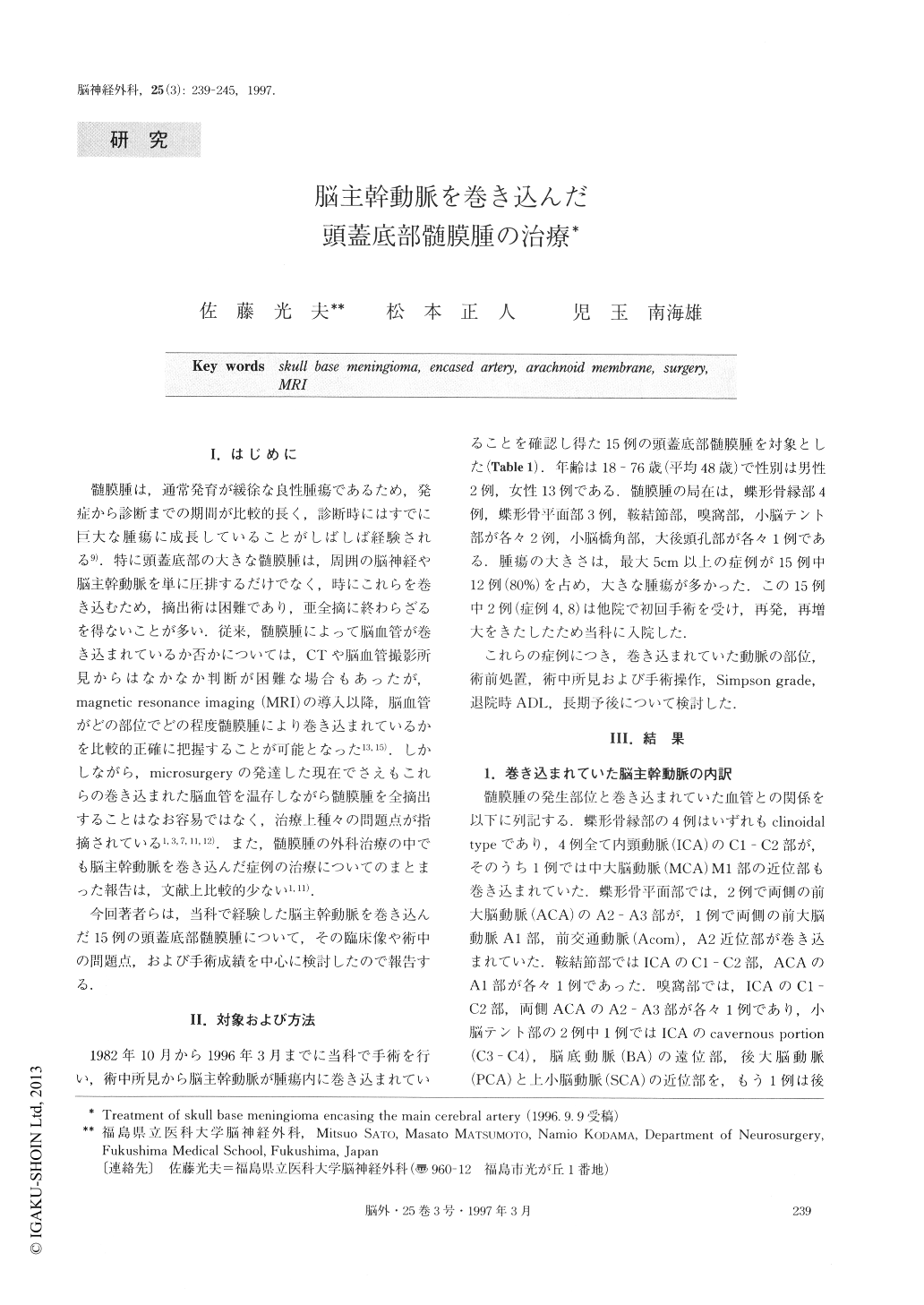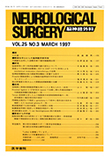Japanese
English
- 有料閲覧
- Abstract 文献概要
- 1ページ目 Look Inside
I.はじめに
髄膜腫は,通常発育が緩徐な良性腫瘍であるため,発症から診断までの期間が比較的長く,診断時にはすでに巨大な腫瘍に成長していることがしばしば経験される9).特に頭蓋底部の大きな髄膜腫は,周囲の脳神経や脳主幹動脈を単に圧排するだけでなく,時にこれらを巻き込むため,摘出術は困難であり,亜全摘に終わらざるを得ないことが多い.従来,髄膜腫によって脳血管が巻き込まれているか否かについては,CTや脳血管撮影所見からはなかなか判断が困難な場合もあったが,magnetic resonance imaging(MRI)の導入以降,脳血管がどの部位でどの程度髄膜腫により巻き込まれているかを比較的正確に把握することが可能となった13,15).しかしながら,microsurgeryの発達した現在でさえもこれらの巻き込まれた脳血管を温存しながら髄膜腫を全摘出することはなお容易ではなく,治療上種々の問題点が指摘されている1,3,7,11,12).また,髄膜腫の外科治療の中でも脳主幹動脈を巻き込んだ症例の治療についてのまとまった報告は,文献上比較的少ない1,11).
今回著者らは,当科で経験した脳主幹動脈を巻き込んだ15例の頭蓋底部髄膜腫について,その臨床像や術中の問題点,および手術成績を中心に検討したので報告する.
We reviewed the clinical findings, the surgical pro-blems and results in fifteen operated cases of skull base meningioma encasing the main cerebral arteries.
The fifteen cases of meningiomas are summarized as follows; The patients' age ranged from 18 to 76 years old with an average age of 48 years old. Thirteen were in female and two in males. Of 15 cases, four cases were sphenoid ridge meningiomas (all clinoidal types), three cases were planum sphenoidale, two cases were tuberculum sellae, olfactory groove and cerebellar ten-torium, one case was a cerebello-pontine angle and foramen magnum meningioma. Twelve cases (80%) had a large tumor of 50mm in maximum diameter. Major advances in imaging modalities, especially magnetic resonance imaging (MRI), have enabled pre-cise preoperative information about vascular encase-ment and location of the encased vessels within the tumor. Preoperative tumor embolization was performed in 2 patients, STA-MCA anastomosis was performed in one patient with severe stenosis of the internal carotid artery encased in the tumor.
In 5 cases with the presence of interfacing arachnoid membranes between the tumor and cerebral vessels, the tumor was totally removed. In the 10 patients without interfacing arachnoid membranes, total removal was achieved in 4 of the 10 patients by the sacrifice of the encased artery and in one patient injuring the arterial wall consequently. In the remaining 5 patients, the tumor could not be removed totally. One patient showed a recurrence on follow-up ranging from 0.5 to 13 years.
In conclusion, greater difficulty with dissection of such tumors was encountered in patients who did not have an arachnoid plane between the encased artery and the tumor. In those cases, to avoid the devastating sequelae injuring the encased cerebral vessels and its surrounding perforators, we considered that total re-moval should not be carried out.

Copyright © 1997, Igaku-Shoin Ltd. All rights reserved.


